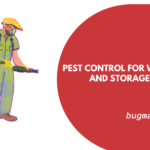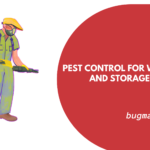
Warehouses and storage facilities play a crucial role in keeping goods safe and accessible. However, these spaces are not immune to the threat of pests, which can cause significant damage to stored items and compromise the overall hygiene of the area.
In a bustling city like Dhaka, effective pest control measures are paramount to maintain the integrity of stored goods and ensure a healthy environment. In this article, we’ll delve into the essential strategies for pest control in warehouses and storage facilities, specifically tailored to the context of Dhaka.
Understanding the Pest Threats in Dhaka
Dhaka’s warm and humid climate provides an ideal breeding ground for a variety of pests. Common pests in the area include rodents, cockroaches, termites, and flies. These pests can infiltrate warehouses through small openings and multiply rapidly if not controlled.
Identifying Common Pests
Rodents like rats and mice are notorious for damaging stored goods by gnawing through packaging. Cockroaches and flies pose health risks as they carry diseases and contaminate surfaces. Termites silently destroy wooden structures, potentially causing structural instability.
Factors Contributing to Pest Infestations
Several factors contribute to pest infestations in Dhaka’s warehouses. Improper waste management, inadequate sealing of entry points, and insufficient employee training on pest prevention are some common culprits. The bustling urban environment can also facilitate the spread of pests from one location to another.
The Importance of Pest Prevention and Control
Maintaining a pest-free environment within warehouses and storage facilities is vital for various reasons.
Protecting Goods and Inventory
Pests can cause substantial financial losses by damaging stored goods. From food items to electronic equipment, pests can compromise the quality and functionality of products, leading to waste and increased expenses.
Upholding Health and Safety Standards
Pests carry diseases that can spread rapidly in closed environments. Contaminated goods can pose health risks to employees and consumers alike. By implementing effective pest control measures, businesses ensure compliance with health and safety regulations.
Creating a Pest Control Plan
To combat pest infestations, a comprehensive pest control plan should be established.
Regular Inspection Protocols
Frequent inspections help identify pest issues early on. Regular checks of storage areas, entry points, and even surrounding environments enable swift response to any signs of infestations.
Integrated Pest Management (IPM) Approaches
IPM involves a combination of strategies such as sanitation, biological control, and targeted pesticide application. This holistic approach minimizes pesticide use while effectively managing pests.
Choosing the Right Pest Control Partner
Collaborating with a local pest control expert is essential.
Local Expertise and Experience
A local partner understands the unique pest challenges in Dhaka and can tailor solutions accordingly.
Customized Solutions for Warehouses
Every warehouse is different. A reputable pest control provider can create a customized plan that aligns with the specific needs of the facility.
Implementing Hygiene Practices
Maintaining cleanliness is a key component of pest prevention.
Proper Storage and Organization
Goods should be stored off the ground and away from walls to minimize hiding spots for pests.
Waste Management and Cleanliness
Regular waste disposal and cleaning routines deter pests from finding food sources within the facility.
Effective Pest Control Methods
A combination of methods can effectively control pests.
Chemical-Free Solutions
Non-toxic traps and barriers can be used to physically prevent pests from entering.
Safe Pest Eradication Techniques
When chemical solutions are necessary, they should be applied with care to minimize risks to humans and the environment.
Employee Training and Awareness
Warehouse staff should be educated about pest prevention.
Recognizing Early Signs of Infestations
Training employees to identify early signs of pest activity ensures prompt action.
Reporting and Response Procedures
Establishing clear procedures for reporting pest sightings helps prevent the spread of infestations.
Monitoring and Continuous Improvement
Pest control is an ongoing process.
Utilizing Technology for Surveillance
Modern technology like sensors and cameras can aid in monitoring pest activity.
Adapting Strategies Based on Results
Regular analysis of pest control efforts allows for adjustments and improvements.
Case Studies: Successful Pest Control in Dhaka Warehouses
Real-life examples highlight effective pest management.
Lessons Learned and Best Practices
Case studies offer insights into what works and what doesn’t in Dhaka’s context.
Sustainable Pest Management
Environmentally friendly approaches are gaining prominence.
Balancing Ecosystem Health and Pest Control
Using methods that don’t harm the environment maintains a delicate balance.
The Role of Government Regulations
Government regulations play a role in pest control.
Compliance with Pest Control Laws
Businesses must adhere to local laws and regulations related to pest management.
Licensing and Certifications
Working with licensed professionals ensures quality and safety.
Emergency Response and Crisis Management
Being prepared for sudden infestations is crucial.
Dealing with Sudden Infestations
Having an emergency response plan minimizes panic and damage.
Minimizing Damage and Downtime
Swift action helps mitigate the impact of pest outbreaks.
Cost-Effectiveness and Return on Investment
Investing in pest control yields long-term benefits.
Weighing the Expenses of Pest Control
While there’s a cost, the expenses are outweighed by the potential losses from pest damage.
Long-Term Benefits for Businesses
A pest-free environment enhances reputation and customer trust.
Engaging the Community in Pest Control
Community efforts amplify pest control success.
Collaborative Efforts for a Pest-Free Dhaka
Working together creates a more effective pest prevention network.
Raising Awareness Amongst Stakeholders
Educating stakeholders about the importance of pest control fosters cooperation.
Conclusion
In Dhaka’s fast-paced business environment, pest control in warehouses and storage facilities is non-negotiable. By understanding the local pest landscape, implementing comprehensive prevention strategies, and staying vigilant, businesses can protect their goods, employees, and reputation. With the right approaches and partnerships, a pest-free future is attainable for Dhaka’s storage industry.
FAQs
Why is pest control important for warehouses in Dhaka?
Effective pest control safeguards goods, health, and safety in storage facilities.
What are the common pests found in Dhaka warehouses?
Rodents, cockroaches, termites, and flies are common pests in Dhaka.
How can businesses prevent pest infestations?
Regular inspections, proper hygiene, and employee training are key prevention measures.
Are chemical-free pest control methods effective?
Yes, non-toxic traps and barriers can be highly effective in preventing pest entry.
What are the benefits of sustainable pest management?
Sustainable methods protect the environment while effectively managing pests.

